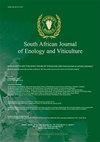南非昆虫病病原线虫控制潜叶蝇Holocacista capensis的潜力(鳞翅目:Heliozelide)
IF 1.1
4区 农林科学
Q4 FOOD SCIENCE & TECHNOLOGY
引用次数: 9
摘要
开普葡萄叶潜蝇Holocacista capensis是一种具有经济重要性的零星害虫,在南非的餐桌和葡萄酒葡萄园中都有发现。由最后一龄幼虫构建的茧壳附着在葡萄串上,对食用葡萄出口市场构成了植物检疫风险。本研究旨在确定采叶H.capensis幼虫对Steinermatidae和Heterorhabditidae七种昆虫病原线虫(EPN)的易感性。为了确定线虫的毒力,从受感染的叶片中提取占用的采叶廊,并在50μl蒸馏水中接种200个受感染的幼虫(IJs),用于筛选的每个EPN。进行了浓度测定,并使用0、25、50、100、200和400 IJs/采叶幼虫的浓度确定了三种最具毒力的物种(鲍氏异杆线虫、印度异杆线虫和诺埃普特异杆线虫)的致死剂量。鲍雅尔迪H.baujardi(92%)、诺涅普氏H.noenieptensis(85%)和印度H.indica(83%)的采叶幼虫死亡率较高。与其他两种EPN相比,穿透昆虫幼虫的H.noenieptensis(34种线虫/昆虫)数量几乎是前者的两倍。然而,鲍雅尔迪H.baujardi的相对效力是印度H.的3.56倍,而印度H.的相对效力则是诺涅普氏H.的2.57倍。实验室获得的结果令人鼓舞,特别是在线虫穿透采叶廊道并成功感染幼虫的能力方面。本文章由计算机程序翻译,如有差异,请以英文原文为准。
Potential of South African entomopathogenic nematodes to control the leaf miner, Holocacista capensis (Lepidoptera: Heliozelidae)
The Cape grapevine leafminer, Holocacista capensis, a sporadic pest of economic importance, is found in South African table and wine grape vineyards. The cocoon casings, constructed by the final instar larvae, can be found attached to grape bunches, posing a phytosanitary risk for table grape export markets. The current study aimed to determine the susceptibility of leaf-mining H. capensis larvae to seven entomopathogenic nematode (EPN) species belonging to Steinernematidae and Heterorhabditidae. To determine nematode virulence occupied leaf-mining galleries were extracted from infested leaves and inoculated with 200 infective juveniles (IJs) in 50 μl of distilled water, for each of the EPNs screened. Concentration assays were conducted and and lethal dose was determined for the three most virulent species (Heterorhabditis baujardi, H. indica and H. noenieputensis), using concentrations of 0, 25, 50, 100, 200, and 400 IJs/leaf-mining larva. High mortality of leaf-mining larvae was obtained with H. baujardi (92%), H. noenieputensis (85%) and H. indica (83%). Almost double the number of H. noenieputensis (34 nematodes/insect) penetrated the insect larvae, in comparison with the other two EPNs. However, the relative potency of H. baujardi was 3.56 times higher than for H. indica, whilst that of H. indica was 2.57times higher than it was for H. noenieputensis. The results obtained in the laboratory were found to be encouraging, especially with regard to the nematodes’ ability to penetrate the leaf-mining galleries, and to infect the larvae successfully.
求助全文
通过发布文献求助,成功后即可免费获取论文全文。
去求助
来源期刊
CiteScore
2.50
自引率
7.70%
发文量
1
审稿时长
>36 weeks
期刊介绍:
The South African Journal of Enology and Viticulture (SAJEV) publishes full-length original Research Papers, Research Notes and Review Papers on all subjects related to enology and viticulture. The SAJEV does not accept articles published in, or submitted to, other journals.

 求助内容:
求助内容: 应助结果提醒方式:
应助结果提醒方式:


